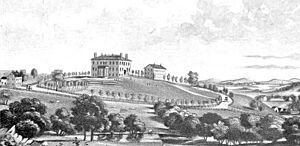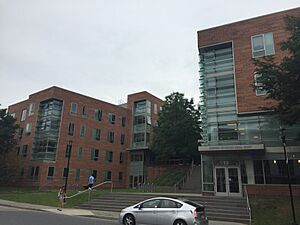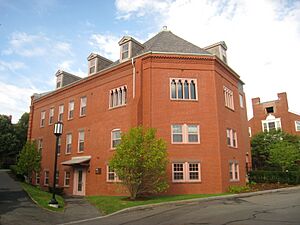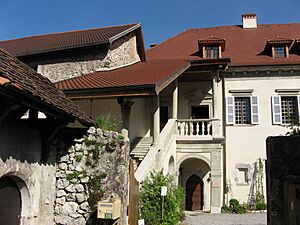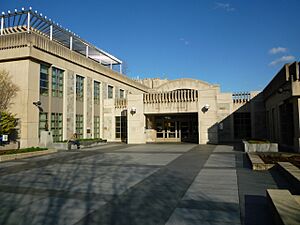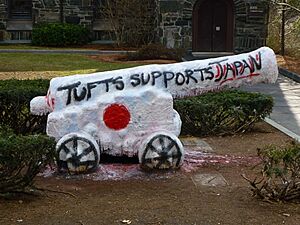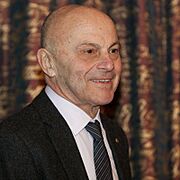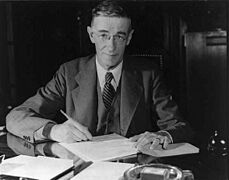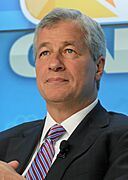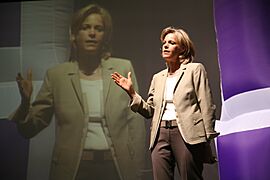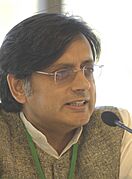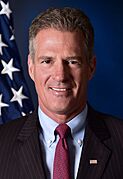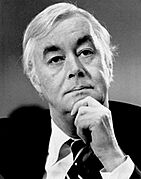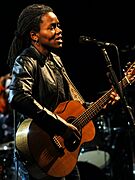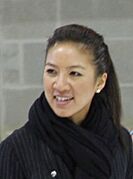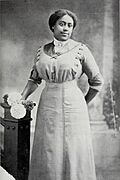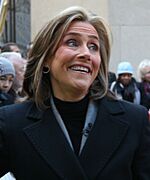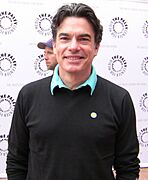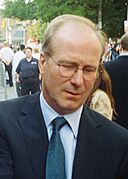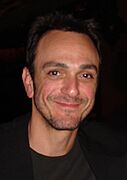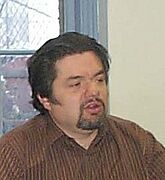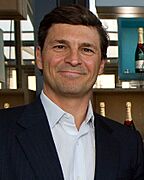Tufts University facts for kids
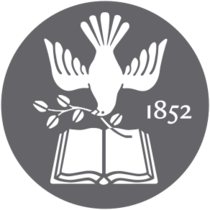 |
|
| Latin: Universitas Tuftensis | |
|
Former names
|
Tufts College (1852–1954) |
|---|---|
| Motto | Pax et Lux (Latin) |
|
Motto in English
|
"Peace and Light" |
| Type | Private research university |
| Established | 1852 |
| Accreditation | NECHE |
|
Academic affiliations
|
|
| Endowment | $2.6 billion (2024) |
| President | Sunil Kumar |
| Provost | Caroline Genco |
|
Academic staff
|
1,288 (fall 2021) |
| Students | 13,274 (fall 2023) |
| Undergraduates | 6,877 (fall 2023) |
| Postgraduates | 6,397 (fall 2023) |
| Location |
Medford and Somerville
,
,
United States
42°24′22″N 71°07′12″W / 42.406°N 71.120°W |
| Campus | Large suburb, 150 acres (0.61 km2) |
| Other campuses |
|
| Newspaper | The Tufts Daily |
| Colors | Tufts Blue Brown |
| Nickname | Jumbos |
|
Sporting affiliations
|
|
| Mascot | Jumbo the Elephant |
 |
|
Tufts University is a private university where students can do research and earn advanced degrees. Its main campus is in Medford and Somerville, Massachusetts, near Boston. Tufts also has other campuses in Boston, Grafton, and even in Talloires, France.
The school was founded in 1852 as Tufts College. It was started by a Christian group that wanted to open a college for everyone, no matter their religious beliefs. For a long time, it was a small college. But in the 1970s, it grew into a large research university that offers many different degrees, including doctorates.
Today, Tufts has ten schools and offers over 90 programs for undergraduate students and 160 for graduate students. Its largest school is the School of Arts and Sciences. Tufts is known for being a top research university, which means its professors and students work on important new discoveries.
Contents
History of Tufts
How Tufts Began in the 1800s
In the 1850s, a man named Charles Tufts donated 20 acres of land to help start a new college. The land was a large, empty hill called Walnut Hill. When someone asked him what he would do with the land, he famously said, "I will put a light on it." He wanted the college to be a place of learning and knowledge for everyone.
In 1852, the government of Massachusetts officially approved the creation of Tufts College. The first building, now called Ballou Hall, was finished in 1854. The school's first president, Hosea Ballou II, based the teaching style on famous universities like Oxford in England.
P. T. Barnum, the famous circus owner, was one of the college's first major supporters. In 1884, he gave money to build a museum for his collection of animal specimens. The most famous item was the stuffed body of Jumbo the elephant. Jumbo later became the university's mascot. Sadly, a fire in 1975 destroyed the museum and most of the collection.
In 1892, Tufts began accepting women as students. This was a big step at a time when many colleges were only for men. The college also started to grow, adding a medical school, a dental school, and an engineering school by the end of the century.
Growth in the 20th Century
In 1910, Jackson College for Women was created as a separate college for female students right next to Tufts. The two colleges later combined in 1980.
The university continued to expand. In 1933, it opened the Fletcher School of Law and Diplomacy. This was the first graduate school in the United States just for studying international relations.
In 1955, the school officially changed its name from Tufts College to Tufts University to show how much it had grown. During the 1970s and 1980s, President Jean Mayer helped the university grow even more. He started new schools for veterinary medicine (animal doctors), nutrition, and biomedical sciences.
Tufts in the 21st Century
In recent years, Tufts has continued to build new facilities and improve its campus. In 2017, the university opened the Science and Engineering Complex, a large building with modern labs for research.
In 2022, a new train station for the Boston public transit system, called the Green Line Extension, opened right next to campus. The station is named "Medford/Tufts," making it easier for students to travel to and from Boston.
In 2024, some Tufts students held protests on campus. They were part of a larger movement at universities across the country related to the Gaza war. The students asked the university to change where it invests its money.
The University's Campuses
Medford and Somerville Campus
The main campus of Tufts is located on Walnut Hill, spreading across the cities of Medford and Somerville. It is about five miles from Boston. This campus is home to all undergraduate students in arts, sciences, and engineering.
The campus is often divided into two parts: "Uphill" and "Downhill."
- Uphill has the main academic buildings and a residential area for students. Some of the oldest and most beautiful buildings are here, like Ballou Hall and Goddard Chapel. From the top of the hill, you can see the Boston skyline.
- Downhill is where the School of Engineering is located, along with other buildings like the campus center and a dining hall. The two parts of campus are connected by a long set of stairs called the Memorial Stairs.
Boston, Grafton, and Talloires
Tufts has a campus in the Chinatown neighborhood of Boston. This is where the schools of medicine, dental medicine, and nutrition are located. The university also has a campus for its art school, the School of the Museum of Fine Arts, in Boston's Fenway neighborhood.
The Cummings School of Veterinary Medicine is on a large, 634-acre campus in Grafton, Massachusetts. This is where students learn to become veterinarians.
Tufts even has a campus in Talloires, France. It is located in a historic building that was once a monastery. Students can study abroad here during the summer and live with local families to experience French culture.
How the University is Run
Tufts University is a private, non-profit school. It is run by a group of people called the Board of Trustees. The trustees are in charge of making important decisions for the university. They also choose the university's president. The current president is Sunil Kumar, who started in 2023.
The university is made up of ten different schools. Each school has a leader called a dean. The main schools for undergraduate students are:
- School of Arts and Sciences: This is the largest school, offering degrees in subjects like history, English, biology, and art.
- School of Engineering: This school offers degrees in different types of engineering, like mechanical and electrical engineering.
One special part of Tufts is the Tisch College of Civic Life. This college was created to encourage students to be active citizens and help their communities. It supports community service projects and research on public issues.
Learning at Tufts
Admissions
Getting into Tufts is very competitive. For the class of 2027, the university accepted only 10% of the students who applied. Students who are accepted usually have very high grades and test scores.
Tufts has a unique application process. It was one of the first universities to let students submit YouTube videos as part of their application. This allows students to show their creativity in addition to their grades.
Studying Abroad and Other Programs
Many Tufts students study in other countries for a semester or a full year. The university has programs at famous schools like the University of Oxford in England and Sciences Po in Paris.
Students can also take classes at other top universities in the Boston area, such as Harvard and MIT, through special programs.
Libraries and Museums
The Tufts library system has over three million books. The main library is Tisch Library. Students can also use libraries at other Boston universities.
Tufts also has a large art collection with over 2,000 works. The collection includes art from ancient times to today. It features famous artists like John Singer Sargent, Auguste Rodin, Andy Warhol, and Pablo Picasso.
Student Life at Tufts
Student Activities
The main student newspaper is the Tufts Daily, which is published every school day. The Tufts Observer is a magazine that has been around since 1895. There is also a student-run TV station (TUTV) and a radio station (WMFO 91.5 FM).
About 18% of students are part of Greek life, which includes fraternities and sororities.
Traditions
One of the most famous traditions at Tufts is painting the cannon. The cannon is a replica of one from the U.S.S. Constitution and sits in the middle of campus. Students paint it almost every night with messages, announcements, or art. By morning, it often has a completely new design.
Tufts is also known for its a cappella singing groups. The most famous group is the Beelzebubs. They have appeared on TV shows like Glee.
Tufts Jumbos Athletics
Tufts sports teams are called the Jumbos, named after Jumbo the elephant. The teams compete in the NCAA Division III in a league called the NESCAC.
In recent years, Tufts has become very successful in sports. The school often ranks as one of the top athletic programs in Division III.
- The men's lacrosse team won national championships in 2010, 2014, and 2015.
- The women's field hockey team won the national championship in 2012.
- The women's softball team won three national championships in a row from 2013 to 2015.
- The men's soccer team won national championships in 2014 and 2016.
A popular tradition at football games is singing the fight song, "Tuftonia's Day," which was written in 1912.
Famous People from Tufts
Many famous people have graduated from Tufts. They have become leaders in government, business, science, and the arts.
- Government and Politics: Bill Richardson, former Governor of New Mexico; Scott Brown, former U.S. Senator; and Daniel Patrick Moynihan, a former U.S. Senator and ambassador.
- Business: Pierre Omidyar, the founder of eBay; Jamie Dimon, the CEO of the bank JPMorgan Chase; and Jonathan Tisch, the CEO of Loews Hotels.
- Arts and Media: Tracy Chapman, a Grammy Award-winning singer; Hank Azaria, an actor known for his voice work on The Simpsons; William Hurt, an Academy Award-winning actor; and Meredith Vieira, a famous journalist and TV host.
- Science: Roderick MacKinnon, who won a Nobel Prize in Chemistry; and Vannevar Bush, an inventor who helped create the first analog computer and founded the company Raytheon.
- Notable Tufts University alumni include:
-
Eugene Fama, Nobel Prize-winning economist (BA, 1960)
-
Roderick MacKinnon, Nobel Prize in Chemistry recipient (MD, 1982)
-
Juan Manuel Santos, former President of Colombia and 2016 Nobel Peace Prize winner (MA, 1981)
-
Vannevar Bush, inventor and founder of Raytheon (BS, 1913; MS, 1913)
-
Jamie Dimon, CEO of JPMorgan Chase (BA, 1978)
-
Pierre Omidyar, founder of eBay (BS, 1988)
-
Shashi Tharoor, former Under-Secretary General at the United Nations (MA, 1976; PhD, 1978)
-
Scott Brown, Diplomat and former United States Senator (BA, 1981)
-
Daniel Patrick Moynihan, former U.S. Senator from New York (BS, 1948; MA, 1949; PhD, 1961)
-
Tracy Chapman, Grammy Award-winning singer (BA, 1986)
-
Michelle Kwan, Olympic medalist figure skater (MA, 2011)
-
Jessie G. Garnett, Boston's first black woman dentist and a Tufts graduate (BA, 1920)
-
Meredith Vieira, journalist and TV host (BA, 1975)
-
Peter Gallagher, actor, musician, and writer (BA,1977)
-
William Hurt, Academy Award-winning actor (BA, 1972)
-
Hank Azaria, actor and comedian (BA, 1985)
-
Oliver Platt, actor (BA, 1983)
See also
 In Spanish: Universidad Tufts para niños
In Spanish: Universidad Tufts para niños
- The Edward R. Murrow Forum on Issues in Journalism
- The Fletcher Forum of World Affairs
- Tufts Historical Review
- Tuftsin
- Tufts Jumbos football
- Tufts Daily
- Tufts Observer
- Tufts OpenCourseWare
- University Press of New England


